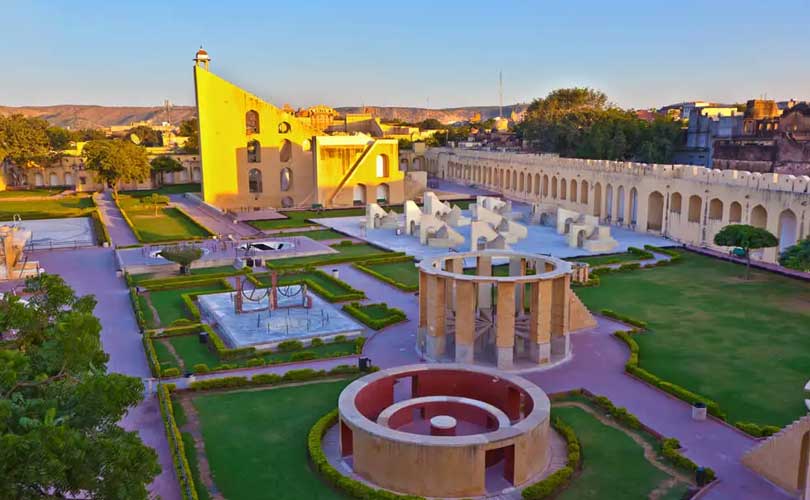
Jantar Mantar, Jaipur was built by the Sawai Jai Singh II in 1734. It is famous for the world’s largest stone sundial and recognized as a UNESCO World Heritage Site. Jantar Mantar is located in the heart of Jaipur. It is popular for stone structures that interpret local time and the position of celestial bodies. There are five Jantar Mantar in India: Jaipur, Delhi, Mathura, Varanasi and Ujjain and the largest among them is in Jaipur. The stone instruments of Jantar Mantar in Jaipur are more accurate as compare to others. There are many amazing instruments which are still working. It is a perfect example of science and knowledge of centuries ago that can be seen till now.
Vrihat Samrat Yantra: The Largest sundial
Vrihat Samrat Yantra is a huge sundial that is placed in the mid of Jantar Mantar. It is famous as the tallest sundial in the world which is 27 meters long. The yantra (instrument) has one triangular wall in the north-south direction. The shadow of this wall travels equal distance in equal time intervals. The standardize movement helps to interpret the local time.
Laghu Samrat Yantra: Small Smarat Yantra
Laghu Samrat Yantra is known by the name Small Samrat Yantra. The word Laghu means small. It calculates the time at to the accuracy of 20 seconds. This sundial has a ramp in North Pole direction. Time can be calculated easily from the position of the shadow.
Ram Yantra:
Ram Yantra tells the position of celestial bodies. This is another major attraction in Jantar Mantar. The instrument is comprised of tube-shaped design which is open to the sky. The instrument has a pole in the center. Ram Yantra is only available in Jaipur and Delhi’s Jantar Mantar.
Jai Prakash Yantra:
Jai Prakash Yantra is comprised of two hemispherical bowls like a sundial. The movement of inverted sky shadows helps to find the positions hour angles, the elevation of heavenly bodies.
Chakra Yantra:
The Chakra Yantra is a ring-like instrument that helps to calculate the hour angle and the co-ordinates of the Sun. It has four semi-circle arcs.
Kranti Vritya:
Kranti Vritya is a special instrument which is used in the day time to measure the solar sign of the Sun. It is also one of the major attractions of Jantar Mantar in Jaipur.
Yantra Raj:
Yantra Raj is a huge metal disc which is marked with various planets. The instrument is used to see the alignment of planets for the horoscopes and lunar calendars.
Nearby attraction:
Best time to visit:
To visit Jantar Mantar, the best time is in noon because in mid-day the sun is in the sky and it is easy to know and understand the functioning of the interpretation process of each instrument.
Entrance timing:
Jantar Mantar remains open for visitors from 9.00 am to 4.30 pm, for the whole week days. One can visit the whole Jantar Mantar in 1 hour approximately.
Light and sound show timing:
Entrance fee:
*Note- Students can get discount only on showing valid student ID proof.
Jantar Mantar is a famous tourist attraction in Jaipur city. If you are planning to visit Jaipur then you must visit Jantar Mantar, the best example of knowledge and science.